Artistic team Marie Wilkinson and Cyril Christo could easily be part of Manhattan and Hamptons society (Christo is the son of blue-chip artists Christo and Jeanne-Claude), but the two have chosen to divide their time between Santa Fe and adventures in Africa to promote their most daring aesthetic/activist endeavor yet.
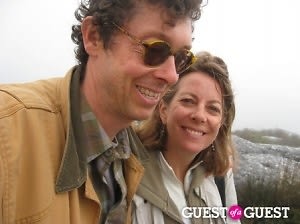
/The couple on Table Mountain, Cape Town, SA May 2010, exhausted after six weeks on the road./
The husband and wife team is currently working on a film called The Last Stand of the African Elephant, part of a long-running mission for animal protection of wildlife. The two, philosophically and aesthetically, feel this movement to be the most important issue of our time and even have their son, Lysander, involved in the fight.
Their book "Walking Thunder: In the Footsteps of Giants" was an admonishment for the preservation of the African elephant and in many ways informs their current project. A mixture of architectural pragmatism and poetic flourish, their approach is fueled by their love for the natural world and for each other. Throughout our interview their banter came colored with light-hearted taquinage and mutual complimenting.
Christo and Wilkinson recently spoke to us from Santa Fe about working together as an artistic couple, why they've limited their time in Manhattan, and their plans to save the elephant:
GofG: I understand that Walking Thunder in many ways set the tone for this next artistic endeavor involving elephants. Could you speak to the roots of your inspiration to pursue this cinematically?
M.W. Yeah, [Walking Thunder] came out in the fall of 2009. And we also did some videotaping, filming, while we were photographing--sometimes the light isn’t great, sometimes we’ve just run out of film at the end of the day, sometimes for our own personal uses. The moving image is more compelling--as compelling or more compelling as the still, or compelling in a different way. And so the book came out and the poaching issue has just been increasing dramatically. We’d be talking but we’d be also continuing our research and following the elephants. A certain amount of the proceeds of each book--we would have to deal with the publisher--would go to organizations that work with the elephants--one is The David Sheldrick Wildlife Trust, and the other is Tusk. It has to be a people-based--it has to be a community-based solution or evolution of how you live. So we kept track of what was going on with the elephants and the increase in poaching, the present Asia market in east Africa, and we decided to stay on it.
And then we took our footage and thought we would make a little short to say something. And that’s how The Last Stand of the African Elephants came into existence. And as we put it together, we realized that something that isn’t just a straightforward Discovery Channel, National Geographic channel documentary but something that actually gets to the poetry and the overarching, philosophical, global importance about the elephants in all our cultures. Not simply, you know here’s an elephant it weighs this much, it lives this long, it does this, it does that. How do we actually tie into our cellular memory, if you will, and recognize that source of so much story, whether it be the indigenous story of a certain place, of a certain tribal group, whether it be, you know, European, American European urban school kids reading Babar and seeing Dumbo. But the elephants are around but they may not be. And what’s happening to them is not only greedy and lustful but outright barbaric.
GofG: It's certainly an interesting artistic project because of the humanitarian bent. Getting into some of the philosophical underpinnings, it seems that you've taken this elephant as a symbol of oneness in the world or spiritual lives. Could you elaborate?
C.C. Elie Wiesel said to save the elephant is an urgent moral imperative. It’s apart from the entire spectrum of the emotional, altruistic, caring capacity of everything that it encompasses, the family dynamics that have been studied with all the researchers that are well-known--it mourns for the Other. It’s an old species of individuals, individuals can be found by the elephants running their tusks, their trunks, rather, over another individual. They probably walked alongside us out of Africa, as far as origins are concerned. Look at it like this: if you were to put two triangles together and they meet at the apex, and the triangle to the left is like origins and the triangle to the right is the opposite of origins, which would be oblivion. So you weigh into the triangle on the right, if you will, if you wanna think of it as being on the right, it’s probably the single issue of our time, the forests, the whales, and the elephants. And the case is those two animals understand who they are, they’re self-aware, they know who they are, they cognize each other, we are affecting our own mind. This is what is not usually understood. There were Tibetan monks who asked what is the trumpet that you used to start all your mating rituals. And this is the voice in Asia of the elephant in their ceremonies; they honor the elephant’s voice and everything that it entails which is one of the 22 aspects of the altruistic mind. One elder called Paquo says man will not exist without the elephants, not just because they’re in Africa and they understand what the others mean to them but in terms of our relationship to the Other, because they have so much ability for compassion, and moving out the way if they see an egg on the floor like in the plains, a lesson we have to learn immediately while the elephants are here or else this elder Paquo says, if we lose the elephants we will lose our minds.
GofG: Do you support activism for other elephant rights, beyond your stand against poaching?
M.W. - I don’t think elephants should be used in circuses, and I don’t think that they should be in zoos…. There’s a book called Elephants on The Edge: What Animals Have To Teach Humanity, and it’s by a woman named G.A. Bradshaw, and that has our photographs throughout the cover and inside. She’s a scientist who has studied the effects of trauma on human beings and is probably the most vocal and scientifically backed opponent to both circuses and zoos. Zoos are particularly troublesome in that they may have one or two elephants and if they only have one, it’s really horrific; they’re really very social beings who thrive in extended family groups and, like us,--like us have stages of social, intellectual and physical development, they need their elders around them. So if you isolate a young elephant or even an older elephant, there are mental health issues which are documented.
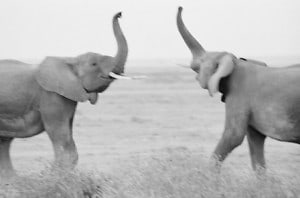
GofG: The elephant is such a symbol of power if you consider Hannibal's march. Do you use such historical depictions of elephants as part of your projects?
M.W. We go back to earlier, earlier marches, like even potentially prehistoric man’s march out of Africa. But we’ve used elephants to help find water and other things over time.
C.C. But one of the kinks is, while we used them for military invasion all the way to the late 19th century in Burma between the Burmese and Siam and of course all the way back to the Greeks and Romans, knocked out the elephants from Morocco--present-day Morocco--all the way to the middle east by the 4th century A.D. unlike native people who may have used the elephant for its flesh to survive, we did it for entertainment and now egregious vanity. We were exploring the hinterlands of Africa, studying mostly the vanity in the late 18th, 19th century when people used the ivory for corsets, piano keys on which Mozart played his symphonies; it was something that had a societal impact, it was something, it’s still a continuation of the vanity, and now it’s gone to the most absurd level so you have cigarette holders and toothpicks and lots of little statuettes that don’t even--you can’t even play the symphonies of the great composers, if you will, on these guys. It’s the most extraordinary--it’s extraordinarily ridiculous. Unlike the hunters in the old days, there is no mythic relationship in what’s happening now, it’s just pure utilitarian impact, that’s the problem with their living on the planet, we just have to understand that. I’ve heard hunters who want to have pieces of ivory for their knives when they go hunting, and other beings like the polar bear not being given maximum protection, it’s now out of utilitarian--what you can get out of nature with no honoring, no reverence. This issue with the elephant is first and foremost about saving a species. But what it means to us boomerangs right back to our own vanity. We have generally made the entire biosphere a slave, if you will, we’re in the process of exterminating it to what end? And those people will have children. Those people who supposedly care about their children, I would suggest they adopt one or two species, give as much as they can, they have to write their senators and say you cannot shoot the bison coming out of Yellowstone. Nobody should be allowed to shoot a polar bear for 40,000 dollars in the Arctic. There’s a tuna that just was sold for 300,000 dollars or so? A tuna--that’s an extension of how we’re treating our entire life-support system.
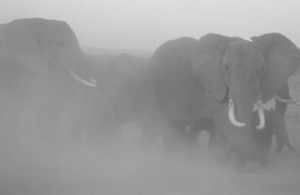
GofG: You operate as a husband and wife team--certainly an interesting experience for two people so passionate about creating art. How does it work, and do you run into disagreements and have little spats during the creative process?
M.W. Well, I think the reason we don’t differentiate between who shot which photographs, with a few exceptions here and there, is because it became quite clear early on that we didn’t know who took which photographs: we were handing cameras back and forth, and we both have the same vision, and we photograph with film. It’s not like having the instant gratification. So you know, it might be a month, might even be two months before we see what we’ve shot. And we hand cameras back and forth, we switch out lenses, pass them back and forth, we direct each other in how we’d like something photographed, if one of us, say, had a wide-angle lens and is photographing a large ceremony, one of us might say to the other, “Oh, why don’t you get down over there since you have a close lens and get that,” or what have you. As far as spatting, and we don’t really--we spat more about logistics than we do about actually making the work.
C.C. Because the rapture...
M.W. Because he forgets to finish his thoughts.
C.C. - Yeah. For me, we have more down time and little arguments like what we’re gonna have for lunch like we had yesterday, because I had a cold and --when you’re in the field you’re in such a place of challenge and discovery, often beauty and hopefully mystery. What I was trying to allude to, apart from the practical is that there’s a lot of documenting going on, but we’re documentarians and for us it’s a story. Our stories make us who we are. And you had someone like Borges, an incredible writer who was blind and can tell you stories. We are very much a visual culture, we need to get the pictures out, partly to enable us to do what we do and to survive but the story that infuses the photographs, that is very important.
M.W. And then you know sometimes when we do interviews, sometimes it’s more important that a male does the interview, particularly when we’re dealing with indigenous people, there’s information that’s divulged to women, there’s information that’s divulged only to men.
C.C. And now Lysander’s getting to, because they like children. But also again it’s imagination that he sees in the books and the stories that we read him at night, they’re activated by what he feels in the larger world. Part of our work is to help the larger world understand that there needs to be a larger world, so these stories have continuity in the world in place and time because is we, heaven forbid, were not to have hippos which are a challenge in the Congo, you know they were knocked out in huge numbers a few years ago for meat, you know a little bit about the elephant situation, and there’s going to be, we can’t say which one, but in very short order a piece that we helped, that instigated from our determination a major magazine is writing a huge exposé on the ivory trade. You will get to see that and it’s the largest of its kind, perhaps in 20 years.
GofG: When you were talking about the creative process and you alluded to Borges and the importance of the visual and the ability to show…do you primarily consider yourself a poet and then a visual artist or is it all in tandem? And Marie how do you identify yourself, first and foremost?
C.C. - The question can be as usual described in a roundabout way... We, I think, the main thing is, if you wonder, you revere and you respect. You cannot wonder and in the same breath shoot something down. You can wonder if you’re a native person, revere and then you honor that being, that being to survive. But the reality is we are first and foremost beings that wonder. You see the cave paintings all over the world, you saw the poets, in our tradition especially over the last thousand years, they’re there to wonder and so we did a label of documentarians, that is, if you capture something beautiful, a story and a moment in time, a film or a photograph you are enabling the world ere to wonder. If we lose the ability to wonder because those beings are not there, we will be surrounded by machines or wires, a plastic world that will not make sense to the next generation.
M.M. - I’m gonna say first for Cyril that he considers himself a documentarian, and so first and foremost he is in the pursuit of all documenting our life and time, what makes life on this planet--
C.C. ...marvelous--
M.W. ...rich. So whether that is manifested in poetry, documentary film, photography or simply writing, yeah sure you could call him a writer you could call him a photographer you could call him a filmmaker but I would say the overarching thing is documentarian. And I guess I would say the same about me but my pursuit came through a fascination with how people live, exploring patterns, and that’s how I ended up doing architecture. There was a fascination with structure and what makes things exist, what makes things work. And so as I was approaching the Lost Africa portion I was looking at how do these people live in an environment and allow it to continue to evolve without destroying it, because so often what’s happening now is included in Africa which is we forget our connection to the place. We forget what we’ve learned from the land. And then we end up overgrazing, overdoing it. And because we have so many people now on the planet it’s not like you can just move pastures. And so what makes a healthy environment, what makes a healthy ecosystem, what comprises a watershed, what are the patterns, what’s the effect of the ungulate on the land, what’s the effect of the elephant on the land, and then story, how did these people--so again it’s documenting, but I think if Cyril’s is more, maybe I’d say more philosophical. Then mine would be more pragmatic.
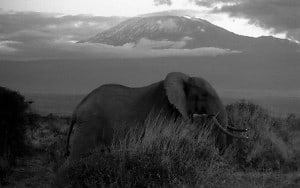
GofG: So you guys combine the documentarian poetry and then the structural pragmatism of the architect?
M.W. - We’re both fascinated by stories. I mean all--pretty much everyone loves stories. So Cyril will be looking at, let’s say, the vertical axis of the story, how it connects the heavens to the earth, and I’ll be looking at that--because that’s what makes it sing, really--but what is absolutely fascinating is the knowledge that is embedded in these stories that allow people, consciously or unconsciously, to survive in their place.
C.C. - That’s a good--the reasoning--she’s more interested in the horizontal, the pragmatic issues, got a very acute awareness and imagination with architecture and how we live in context, and I am more interested in the poetic in terms of what makes human speech but in relation to flesh, so we are looking---
M.W. Cyril’s French and I’m American, OK? I think that kind of encapsulates it.
C.C. William James pragmatism versus Baudelairian hyper-poetics, the poetics of space, but they’re both necessary.
M.W. They’re both necessary, they have to both exist for us to survive. If you hang out in either of ideas or ideals, then you can’t--you’re not connected to your land. And I mean, in America we have phenomenal stories, particularly out here in New Mexico, we talked to the pueblos and they can tell you how story is informed by language and language informs stories. And there is an understanding that as we grow older our--the capacity to understand a story on multiple levels grows, while a story for a child teaches one little bit, you know, maybe don’t play with fire you might get burned, but so then when you’re a teenager there’s a whole other meaning that you’re either told about or blossoms out, then when you become a junior elder there’s another layer of story that is understood, kind of, say, “how come I didn’t see that before?” Well, you’re just not--you can’t. Your experience just isn’t such that you can.
GofG: Why do you winter in Sante Fe and abandon Manhattan for the better part of the year?
M.W. - We skied all day Saturday and it did snow a little bit last night and it’s about--we’re about to get an arctic blast. The temperature right now is in the 30’s.
C.C. D.H. Lawrence, when he came here, saw the beauty of the pueblo in relation to their cosmology. And one of the things I urge you to listen is the pragmatics of what we looking at and the natural cycle of rain and drought we’ve been looking at with people and the wildlife and the connection between the two, which is very very important. We are, if you will, we are looking at the stars, we looked at tides in relation to planets and all this and cycles of drought and when Venus appears and this and that happened and we’re generally, apart from our sophistication technologically and our looking at the planets and the rings of Saturn and supposedly finding planets and they have water, we don’t really have a cosmology that holds us to the earth. Which is very very important. And the elephant and all the creatures--we were marveling last night at two beautiful beetles, I’m not sure exactly what name they are, and I should, but they’re gorgeous. We make sure we don’t step on this beetle. Because this beetle like the bees, there’s a story about the bees we could tell, we could go on for six hours, but we have to find our place in terms of flesh, and our minds and spirit. And what the elephant does ,like no other being on terrestrial ground, like other big--its mirror image is the whale is that they know who they are, they form part of who we are in the world. And the reason that the native people had a cosmology and that is something you learn in the field by watching their ceremonies, bumping into them at the grocery store, you have impacted the because they said “we have lost the cosmos”, we, in a metaphysical way. Part of our research is going between the very physical and material--the sand, the mosquitoes, the drought and the cycles of everything that’s going on and then the stories that infuse a larger poetic and the native people here still have that.
M.W. - I’d say really simply, in a quick, succinct answer, nature and culture, and four seasons. So--we have the, I don’t know how to say this really diplomatically but we also have--we’re on the east coast in the summer and we have to get an infusion--
GofG: Are you out in the Hamptons in the summer or are you in the city?
M.W. Well we’re in Amagansett and then we come into the city on the sporadic dates: meetings, publishers, galleries.
GofG: How did you two meet, originally?
M.W. Through a friend, through a really good friend of mine--a German friend--who was working on the Reichstag project in Berlin and all my friends--I worked as an architect in London for a while and then I came back to New York and I finished all my licensing exams and I was about to take them and I had a call from my friends who were all working for Norman Foster, on the renovation of the Reichstag in Berlin and they said why don’t you come over--my birthday--so I went over and I met him and we became great friends and then he came over that summer and it was indirectly through the movies at Bryant Park that Cyril and I met. We met at Yaffa Cafe in the East Village. And then we drank sake at the bar and talked about New Mexico because he was working on a documentary there.
C.C. And also, the really--you get sunsets here, you get the best four season weather system probably on the planet, you’re not gonna get tsunamis or hurricanes in little baby--You have very, very good lectures, you get the natives and the artistic quadrant of experience, you get quantum physicists and astronomers and you get a number of things and then sometimes you are just amazed by the life. And the other day I mentioned there was a buck trying to come into the house on our steps, it was like nature saying “hey I’m still here” and I was looking for a cat and a beautiful guy with a rack of horns was on our front steps. It was fantastic.Yeah, sometimes you have mountain life crawling through and again it’s part of that mystery, that larger dialogue, it isn’t just trying to record--look at the beauty of nature because if you’ve got an interest in the larger architecture of experience and the poetics of space you understand that this period is an extraordinarily important thing, and a lot of the distractions, they come from the cultural world that I was very deep in and has its place, I think the largest dialogue of our time by far, will be how we connected to life. With all due respect to the buildings being put up, the art being put up--
M.W. I would say that your having grown up in SoHo in a time when there were not a lot of kids around, it was dark.
C - I’m just saying what makes this planet--
GofG: You’ve mentioned your view of cosmos and this and that. What are your religious views, do you incorporate those into your art?
M.W. No. I would say we’re spiritual, not religious.
C.C. Nothing beats nature. That’s all there is and everything else is just a subset of that. Absolutely.You look up at the stars at night, you know, if you can see the stars, that’s a big one, and you’re awed. You’re simply speechless. And that’s the end of the story.
GofG: I know, Cyril, you’re not a huge fan of talking about the connection between your parents as artists, but because you work as a husband and wife team, do you learn anything from watching your parents over the years that you’ve now incorporated into your collaborations with Marie?
M.W. It’s about us working together and learning lessons--
C.C. They have it pretty wrapped up because they understand that the beauty of the ephemeral, the product of the involuntary beauty of the ephemeral, of course he does it in a way that could only come from a human being but is synthetic because everything that we do is based on a human-generated idea, what it does is it goes away. So the beauty of the ephemeral is a very big one, several, and that helps us understand the urgency of the life quotient, the life--the message right now because there are so many things that are ephemeral that are being challenged, I don’t want you to write a piece where it’s just about photography. The past cannot be forgotten in any way, shape or form if we’re going to have a future. Lysander is a part of our work because we can’t have the knowledge of him staying behind and watching video games. He’s been to Africa a few times and he is mesmerized. He has a good time with the kids and the kids at school and the teachers, and we have to go back in the filed for over a month to keep in touch with what’s going on. It’s part of his life. Something’s going on you can’t always just run into a Starbucks or run into another store and feel like “oh gosh we’re in charge, let me buy something”. You have a larger elemental reality, those beings are not just our allies, especially in terms of the elephants, they are our peers. We refuse to acknowledge that. A Hopi-Apache elder mentioned a few nights before he told me a date of no return, he basically said 2025 is the point of no return. Which means that our entire civilization has to change in terms of energy priorities, who we are, because Hope, going back to why we’re in the southwest, I was very interested in the elders’ understanding of the prophecy rock. Prophecies are very important, not as a new-age pastime but as true world-standing events. The circles on prophecy rock probably can relate to World War I and World War II. I believe we’re in the middle of it and it’s not a bomb, it’s not a nuclear, heaven forbid, it’s a psychic disconnect from nature. That is the biggest thing, a lot of photographers who take pretty pictures don’t articulate it in that way. We went around the world to listen to elders in Australia, we crossed the Tibetan plateau in July of ‘99, the year--the month JFK Jr. went down, we learned a lot of things from people who have real culture because we have a society that doesn’t have real knowledge transmitted to the young, that’s why they’re on drugs, it appears they’re doing the same thing with tattoos and green hair, or purple or whatever. Because when you look at real, at native people, when they do those things it has an intent, it has intelligence behind it. That’s a very big difference. So what we’re trying to say, we have to bring the, I always say that the end will come with the killing of the whales, although that’s generally subsided and not as many whales, thank God, are being killed now as 30 years ago, the killing of the whales, though, and the elephants in terms of mass, are the two arms of the largest crucifixion, biological crucifixion of our time, the two arms. Our vanity--one of the great stories of the world, the elephant, is being destroyed, they’re dying from vanity. You can be sure that at some point we’re next because we are imbalanced. The physical, biological, but also spiritual, the metaphysical because the guys who don’t wanna go listen to it, shortly, the psychic connection will knock your socks off. We don’t have that. The biggest issue of our time is whether we save the life force on this planet. Our work is a call, is an alarm call for what’s left of life. And the fact that we’re using every energy to make sure that our son comes with us is really a plea and a prayer for the next generation.

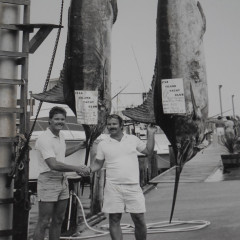
.jpg)
.jpg)
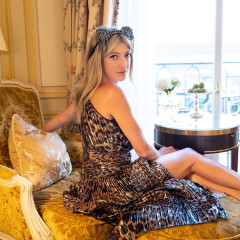

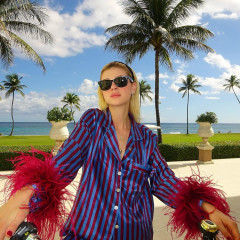
.jpg)
.jpg)
.jpg)
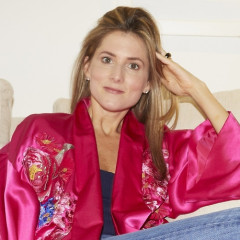
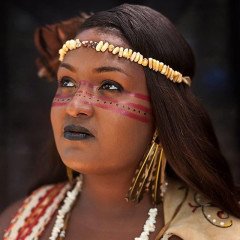


.jpg)